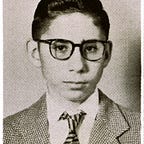Rich & Famous When You’re Dead
A friend of mine, we both live in Vancouver, BC, has just received the Order of Canada but he does not plan to be around in our present three dimensions (and that fourth one of time) to receive it. Both of us understand that posthumous awards and posthumous recognition is worthless. I am almost sure I am going to be rich and famous when I am dead. But it is not going to do me any good. I am presently attempting to convince my friend to spring for a new tuxedo and to get a round-trip ticket to Ottawa and collect the award “vivito y coleando” (alive with one’s tail fluttering about). It all made me remember how fleeting fame can be for even those who deserve it.
In 1967 I arrived in Mexico City from Buenos Aires not knowing what I was going to do with my life. On one side of my family they suggested I teach Spanish and English. This I did immediately. But one of my cousins seemed to know better. Robby Miranda told me, “What do you want to do?” I answered, “I want to be a photographer but I don’t have any darkroom equipment to process the film I shoot. I would like to print my stuff, too.” He dragged me to American Photo Supply on Avenida Madero and pulled out his American Express. “Let’s get what you need.”
If it had not been for Robby I would be doing something else today. I think I would be quite bored. Robby at the time was a dealer for Tefal frying pans and had contacts with large ad agencies. He arranged for me to teach English to the wife of a highfalutin account executive called Manrique. He then arranged for Manrique to get me to assist (without pay ) the best commercial photographer in Mexico and in Latin America. This was a German called Arno Brehme. His father, Hugo was better known as the man whose postcards introduced the world to the volcanoes and beautiful landscapes of Mexico. But Arno Brehme was shooting all the car ads for the biggest and most popular magazine, in Latin America. This was Life En Español.
I showed up at Brehme’s studio in upper Constituyentes, almost in the outskirts of Mexico City. The studio was built to resemble a huge airplane hangar. In this studio Brehme could shoot a car on one end, A bathroom in another and several more setups in between. Brehme had assistants, many of them but his principal one was called Seco (I believe). One day Brehme was shooting a row of Jell-O boxes. “Alex, where would you focus this 4x5 if you want to have the whole row of boxes in focus and sharp?” At 25 I thought I knew everything so I quickly answered (incorrectly), “Half way.” Brehme was much too gentle to pounce on me so with patience he explained the correct answer.
In those days there were many b+w photographs produced for layouts. Brehme taught me to spot the prints (remove traces of dust on negatives which produced little white spots on the photographs) with Spotone (a series of three bottles containing a dye that penetrated the emulsion of the photograph and when dry left no trace). I remember little else of the man except for one very important incident. He showed me an artist’s rendering of a car in a garage lit by moonlight that was supposed to be an ad featuring a Plymouth Barracuda. He showed me how the moon would naturally cast the shadow in an opposite direction. He then pointed out that the artist had put the shadow incorrectly. “The idiots have no idea of the properties of light. I will light this ad and make it exactly like what they want even though it is impossibly wrong. But this is tiring.”
Shortly after he sold his studio and most of his equipment and dedicated the rest of his life to environmental issue photography. I returned to Mexico in 1989 and somehow I found him. He was in bed and looked ill. He had no idea who I was and I have little memory of what we talked about. I wanted to explain to him that he had taught me more than he would have ever suspected. For years after I lost all contact and I don’t even know if he died or is still alive. It was only recently that I found two pictures of him (and little information on the importance of his contribution to advertising photography in Mexico). They are both taken by a photographer called Roberto Hall. The colour photograph he took in 1965 and the black and white one in 1967.
As I teach my students photography in Vancouver I note that many of them are around my age when I assisted Brehme. They are probably much better photographers than I was. And I know that many years from now I will be lucky if they remember one or two small things I might have taught them.
My friend, eager to avoid fame in the afterworld, and I, both understand that this is the normal course of events. It will not make the least difference to us once we are gone. Now if I can only convince him about that tuxedo.
Originally published at blog.alexwaterhousehayward.com.
